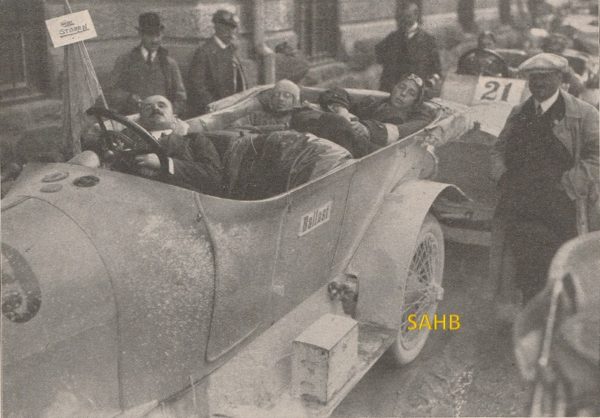
If anyone had any doubts as to the toughness of the Austrian Alpine Trials, perhaps this Snapshot will correct any misapprehension. It is one of three different photographs to display sleeping competitors in the same report of the 1914 run. One person was lying on his coat on a pavement. Another, F S Bennett, the London Cadillac dealer, was seen fast asleep leaning on the front wing of one of the three cars he had entered. And in our Snapshot the driver Graf (Count) Schönfeld and his team are flaked out in their car, the 4.4-litre Fiat Number 19.
There is more evidence of the massive challenge of the 1914 trial. A report in The Times of June 30th 1914 gave the results and included these revealing words:
“… for many of the smaller machines the 1914 Alpine contest has been terribly severe. To get the car through the day’s run, to get it to the control, to go on, has been in many cases a heart-breaking strain on the men, and no praise is too high for their courage and determination.”
The Austrian Alpine Trial or Oesterreichische Alpenfahrt was first run in 1910, making it older than the Rallye Monte Carlo inaugurated in 1911 by Prince Albert I of Monaco. Its route across the Alps gave it the reputation as one of the hardest rallies in Europe before World War I. Between 1912 and 1914 Audi Type Cs (Alpensieger) proved their reliability and toughness by winning the trial in three successive years, but in 1913 and 1914 it was also the scene of remarkable successes for Rolls-Royce. After a failure in 1912, attributed to the limitations of their three-speed gearboxes, a team of four cars – three works entries and one driven by the independent James Radley – gained six awards including the Archduke Leopold Cup. James Radley entered a Rolls-Royce alone in 1914. It was consistently the fastest car and one of only 15 to lose no marks throughout.
To return finally to our Snapshot: it may seem bizarre that even a totally exhausted Graf Schönfeld and his team could remain undisturbed while surrounded by so many spectators and officials. The simple answer lies in the flag sticking out of the car alongside the sleeping Count. It carries the handwritten sign that will be familiar to anyone staying today in a German or Austrian hotel. “NICHT STÖREN” (Do Not Disturb).
Picture courtesy of the Richard Roberts Archive







Leave a Comment